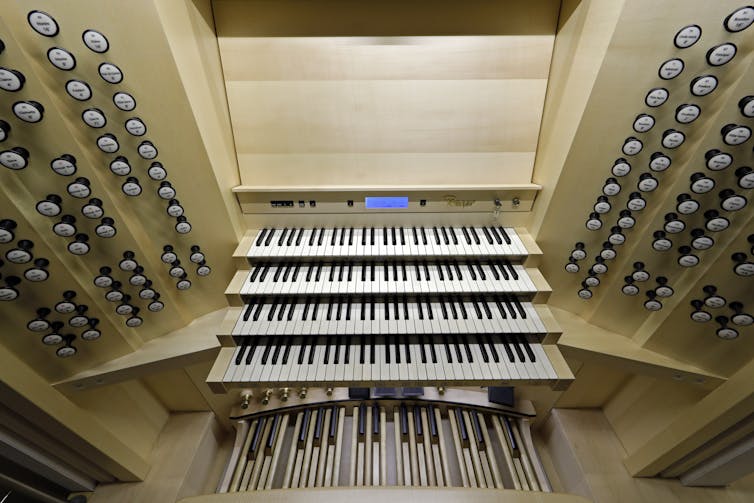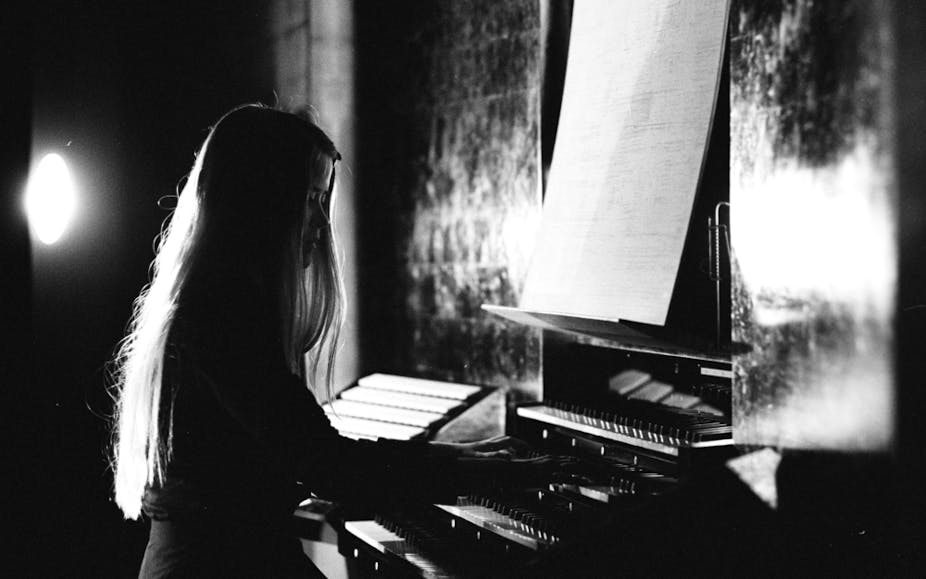Unlike most musical instruments, the pipe organ is commonly defined by the place where it’s often played: church. And people seem to think of organists as reclusive creatures in the lofts of basilicas and cathedrals.
The pipe organ is a musical instrument that creates sound by pushing air under pressure through pipes which corresponds to a particular keyboard called a manual. The pipes are placed in specific formations called ranks, each containing the same sound character.
Pipe organs have a variety of pipe ranks of different tone, pitch, and volume that can be used on its own or in combination. For an instrument to qualify as a pipe organ, it should have at least one manual and one rank of pipes. In larger instruments it can have as many as seven manuals and hundreds of pipe ranks. Most organs have a pedal board which is operated by the feet, based on the same sound-producing principle as the manuals.
As an organist myself, I have come across many preconceptions and questions about the instrument.
Some people think it suitable only for playing hymns or “old” music, boring stuff devoid of much artistic merit. In fact, the repertoire spans most music genres, from capricious preludes and fugues to jazz-inspired pieces.
Organ music has even ventured into alternative rock. The Swedish organist Anna von Hausswolff, for example, creates a magical effect in a contemporary style with drum kit, electric guitars and all.
Other than church, the organ is often perceived as belonging in horror movies. This is the legacy of Hollywood productions of the early 20th century. The Toccata and Fugue in D Minor (BWV 565) by Johann Sebastian Bach (1685-1750) frequently suffers this association. For some, this music now conjures up the cliche of the haunted castle in moonlight. Outside, werewolves howl. Inside, in a cavernous, smoke-filled room, the petrifying silhouette of a blood-thirsty Count Dracula performs a Transylvanian polytonal death march on a three-manual organ (one with three rows of keyboards).
Yet the organ is capable of producing some of the most celestial and soothing harmonies, as well as triumphant proclamations.
Durable and complex
As long as organs have existed – 500 years – composers have been writing for them, in every conceivable style.
A well built pipe organ is an exceptionally durable instrument, unlike the electronic and digital versions. With biannual tuning, regular maintenance and re-leathering every 50 years, it could last for centuries. This work gets done by a number of pipe organ builders around the world.
The world’s oldest functioning and playable organ is in the Basilica of Valère in Sion, Switzerland. This astonishing instrument dates from about 1435. This instrument would have been brought to Valère at the expense of Guillaume de Rarogne, a powerful figure who ended up as the bishop of Sion. It still has most of its original case and a few pipes. The rest have been replaced or altered in restorations, the most recent in 1954.

Until the Industrial Revolution, the organ and the clock were the world’s two most intricate and complex human-made artefacts.
Looking at the front of a pipe organ, one sees only the relatively small number of pipes in the façade. The bulk of the pipework is usually found behind this decorative part. For instance, the world’s largest organ, in the Boardwalk Hall Auditorium in Atlantic City, New Jersey (USA), has 33,114 pipes, only a few of them in the façade. Some façade pipes are only there for aesthetic effect and are referred to as “dummies”. Pipes are generally made from an alloy of tin and lead.
Range of sounds
A common misconception is that the organ is only capable of playing loudly. It can easily be played more softly by using “Venetian swell shutters”. These are separate boxes of pipes, opened and closed by a pedal to decrease the volume. The organ can also play quietly by employing fewer registers or “stops”.
The stops are used to stop the air from flowing through the pipes. As explained by the organ specialist website Nazard,
The stops are part of the action that controls which pipes are allowed to speak and which are to remain silent.
Conversely, by “pulling out all the stops”, one can increase the volume. This technique of manipulating sound debunks the notion that the organ’s sonic properties are expressionless in comparison to those of the early piano, the pianoforte.

People sometimes ask whether only old people play the organ. Definitely not. Many organists start learning while very young.
It helps if their feet can reach the pedal board. Any performer needs to use the feet as a “third hand”. These pedals are usually to produce the low-pitched notes.
So, the next time you see or hear a pipe organ, remember that this instrument is more than a box of whistles high up in a dusty loft. And please don’t mention Count Dracula.

